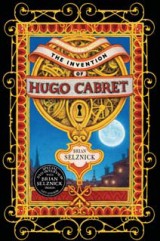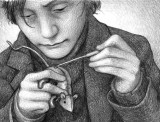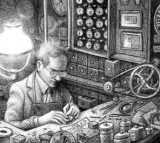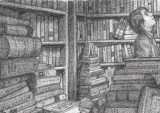Enter the world of Hugo Cabret, a magical mixture of graphic novel, picture book and film narrative which, says Judy Clark...
Enter the world of Hugo Cabret, a magical mixture of graphic novel, picture book and film narrative which, says Judy Clark, will obsess your class for weeks…
Well-known illustrator Brian Selznick’s intriguing The Invention of Hugo Cabret is a real treasure. I’ve known children that have gone home and pleaded for their own copy, which, once secured, has then been spotted carefully tucked under an arm throughout the school day – when it’s not in the midst of small crowd that has gathered to explore and discuss it page by page, that is.
Set in Paris in the 1930s, the book’s hero, Hugo, is an orphan who lives alone inside the walls of a train station. The one possession he has he guards fiercely – a small notebook of mechanical drawings and notes which belonged to his late father. Hugo’s world collides with a bitter old man and his daughter to reveal incredible secrets long hidden.
Part of the narrative is told through bursts of filmic illustrations which create real pace and delight for children as the story comes alive. Fiction and non-fiction merge as we discover that the old man is in fact a real magician and famous early filmmaker. The opportunities for extended crosscurricular literacy work are immense – not only is there the chance to explore key narrative elements and themes of friendship, loss and redemption but also to develop children’s understanding of film narrative techniques and the growing world of multi-model text. Jumping-off points into non-fiction and other ares of the curriculum are many.
 Discuss the central themes of hugo cabret…
Discuss the central themes of hugo cabret…
Introduce the idea of a creative scrapbook to the children where they can record all their thoughts, findings, questions and reflections about the book – their own ‘Guide to the world of Hugo Cabret’. This will act as a reading and writing journal for use throughout the work where they can record their ideas, story map the plot and build on character studies throughout the narrative.
Hold discussion topics on themes that will arise as the story develops using question cards.
Key discussion questions:
• Is stealing ever acceptable?
• We all have special talents – do you know what yours is?
• Which do you prefer, pictures or words, book or film?
• If you have lost someone, how do you remember them?
• What would it be like to be an orphan and live on your own?
• How important is friendship to you?
• What would it be like to have to work at an early age to survive?
 Put the spotlight on character…
Put the spotlight on character…
The key elements of character and setting can be explored in depth throughout the book with the children recording their own writer’s tips and tracking how the characters develop and change. Drama and discussion will be central.
Recreate with the children Hugo’s room in the station’s secret apartments using the detailed setting description from the book and Selznick’s illustrations. Using the environment created, explore through role-play and thought tracking how it might feel to be Hugo, alone in this room every night. What does the room and its objects tell us about Hugo? Use ‘role on the wall’ to record in scrapbooks what is known about Hugo and what the children consider may be his thoughts and feelings.
As the story develops we find that Hugo is by definition a thief. Create a court scene drama to put Hugo on trial. Who might his character witnesses be? Who will be his prosecutor? The jury must decide as Hugo takes the stand.
In chapter six Hugo and Isabelle talk together about what their lives will be like in the future, what their purpose is and their talents. Children can discuss what talents and qualities they have found in the characters and predict what may happen to them. Further reflection in their scrapbooks about their own talents and purpose could then be explored.
 Assess the power of still pictures…
Assess the power of still pictures…
Begin by reading aloud the narrator’s introduction to the book by Professor H. Alcofrisbas, who interestingly will return at the end of the book. As he encourages, complete a short visualisation, ‘like the beginning of a film’, of the opening scenes to the story. Watch the opening sequence of illustrations, available as a slide show on the official website http://www.theinventionofhugocabret.com, or read together using a visualiser.
Explore the children’s response to the opening chapter, entitled ‘The Thief’.
• Where and when do they think the story is set?
• Who do they think Hugo is?
• Why is he in the train station?
• How does he know the station so well?
Discuss the visual techniques used by the illustrator and explore the language of film narrative using the sequence to help illustrate the techniques and their effect on the reader. Some excellent pointers on camera angles and their use can be found at http://www.filmeducation.org. Children might complete a shot by shot analysis of each picture still.
As a class, use freeze frames to recreate a selection of the opening scenes and allow the children to experiment with digital cameras and video to explore different camera shots, close-ups, high and low angles, long shots etc. and the effect each has on the audience. Children can act in turns to narrate the story using the scenes as reference.
Explore the use of black and white in the opening sequence.
The children could then compose their own written version of the opening, translating pictures to words and compare the effectiveness of each.
 Investigating the real George Méliès…
Investigating the real George Méliès…
The drawings and annotations in Hugo’s precious notebook are stolen by the old man, Papa Georges. Hugo’s life work has been to use them to bring to life the broken automaton owned by his father. We discover that Papa Georges was once a celebrated magician and filmmaker, the real-life filmmaker Georges Méliès.
Children can explore and make notes on the life and works of George Méliès. The Hugo Cabret website has a huge variety of information and support on Méliès’ early film making. Children could then produce a biography of his life.
There are many interviews both written and filmed where Brian Selznick has spoken about his inspiration for this work. Children in groups should develop key questions they would like to ask the author / illustrator and then create an author profile to add to their scrapbook.
The book also includes a photograph of a famous train crash at Montparnasse station in Paris which Hugo dreams about. Children could research the crash and write a front page newspaper article of the event.
 The possibilities are endless…
The possibilities are endless…
• The distinctive illustrations would be an ideal stimulus for work around the use of line, tone and shading. Children could imitate the illustrator and pose as models to sketch in black and white.
• Explore France, the city of Paris and its tourist features seen in the book.
• Colour wash the opening image of Paris by night with the Eiffel Tower as a silhouette.
• In DT build your own paper automaton as a moving toy.
Judy Clark is the Talk for Writing manager at the National Literacy Trust (literacytrust.org.uk).
Teaching five year olds to talk
Ace-Classroom-Support
Becoming a teaching school
Ace-Heads
